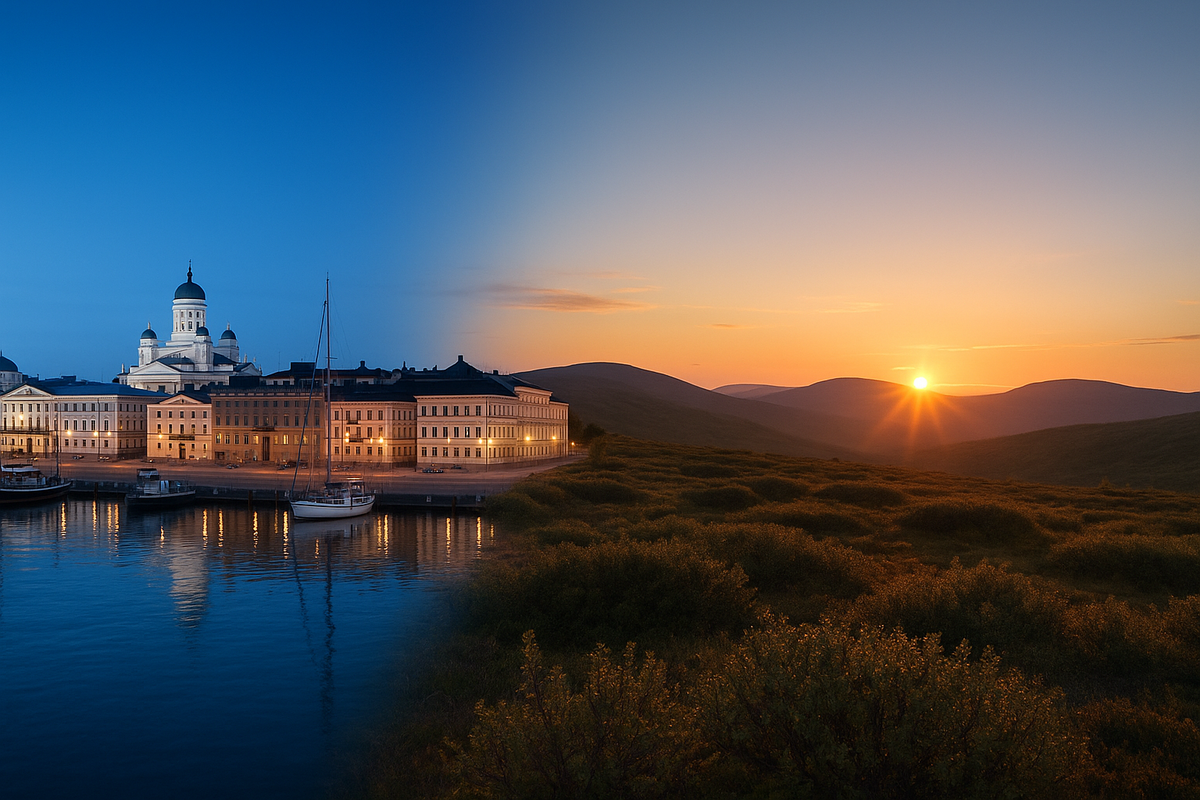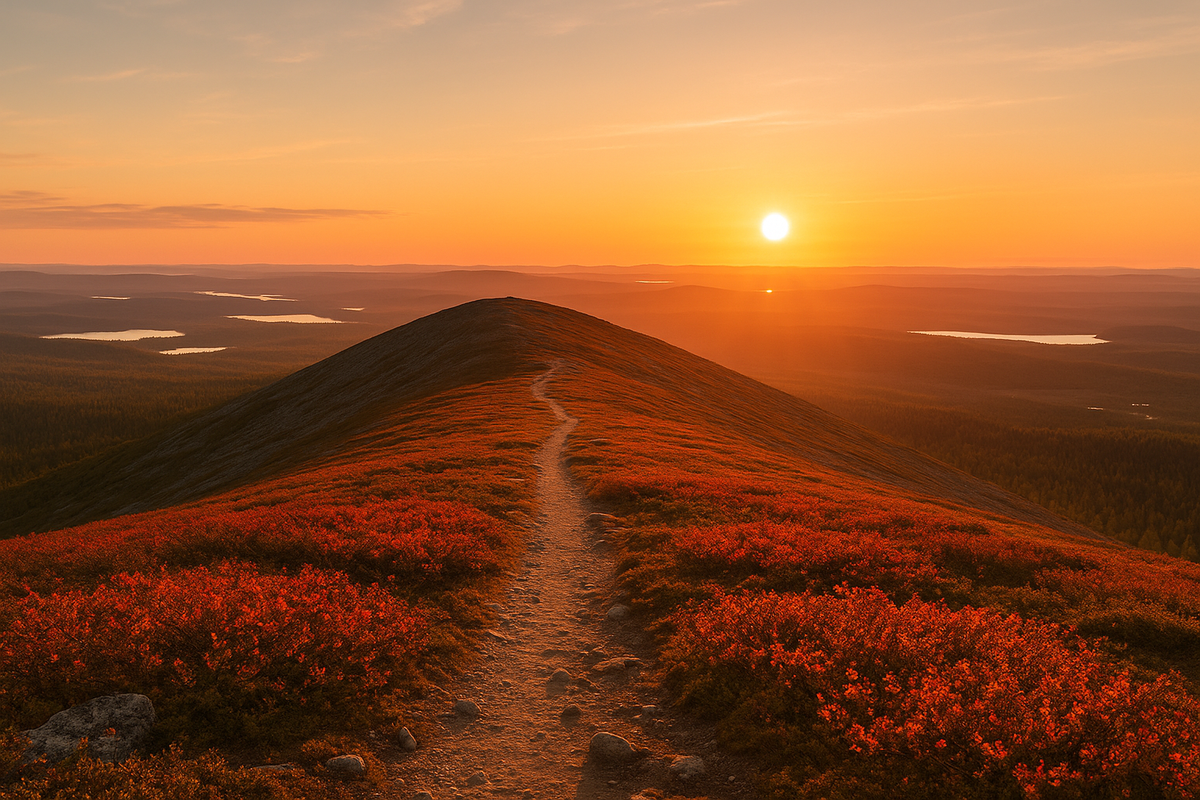🌞 White nights and polar day: south vs Lapland — a complete guide to light without darkness
Prepare to be amazed as you discover the enchanting phenomenon of white nights in the south and the awe-inspiring polar day in the north. Uncover the secrets behind how "night" transforms into soft twilight, allowing you to enjoy late walks, stunning photos and activities without the need for a torch. We'll give you the lowdown on the best windows for each region, the ideal daytime length, wind and temperature thresholds that'll keep you comfy, super-useful sleep hacks, and a handy list of everything you need to pack. A dash of facts, a sprinkle of intuition — and you'll have a summer plan ready to go in no time, with no worries about the dark!
What it is: white nights vs. polar day
White nights are when there's still light twilight at midnight (southern and central Finland). The polar day (Midnight Sun) is something you can see north of the Arctic Circle: the sun doesn't set for weeks (Lapland: Saariselkä, Inari). When it comes to planning, this means more freedom when it comes to time and late-night activities, but it can also make it tricky to get enough sleep. Below, we've got some easy 'light hygiene' tips to help you out.

Light calendar by region: windows and duration
Temperatures and "feels like" in summer
In the south (Helsinki/Turku) in June–July, temperatures are around +18...+24 °C during the day and +12...+16 °C at night; the sea breeze "takes away" 2–4 °C in terms of how hot or cold you feel. In Lapland (Rovaniemi–Inari), temperatures are pretty comfortable at +14...+20 °C during the day and +6...+12 °C at night, and the air is drier, making it easier to walk and ski. When you're out for a midnight stroll, remember to pack a light windproof and a thin hat. And when you're on the water, keep a life jacket handy. In the archipelago, stick to the closed straits for safety.
Juhannus (Midsummer): what you need to know
The midsummer holiday is usually at the end of June. In cities, some cafes and shops close early; in coastal areas, there are bonfires, picnics, and people head off to the islands. Make sure you book your accommodation and ferries in advance, and plan your shopping for the first half of the day. When it comes to taking photos, a soft "midnight" light and calm bays are the perfect setting.
Late evening: ideas for activities (by region)
Helsinki. Route: "cruises to Suomenlinna — Eira/Katajanokka embankments — sauna by the water." When the wind is 6–8 m/s, head to the sheltered embankments.
Turku/Åland Archipelago. SUP/kayaking in narrow channels in calm weather; in gusty conditions — walking loops in pine forests, cycling routes around the islands.
Lake District (Saimaa, Päijänne). In calm weather — mirror-like reflections, fog at dawn; short routes around Haukkalampi and piers for picnics.
Lapland (Saariselkä, Inari). Midnight hikes on soft fells; it's cooler on the ridges — add a membrane.

Sleep and rhythm: life hacks without complicated terms
— Sleep mask + thick curtains/clips.
— "Anchors" — shower, herbal tea, book; put away screens an hour before bedtime.
— Finish training before 8 p.m., otherwise adrenaline will delay bedtime.
— Children: "dark house" (light cover over the bed) and a repetitive evening routine.
— Jet lag? Morning sun + a short 20–30 minute power nap during the day.
Practical thresholds: wind, water, comfort
What to bring: a "capsule" for white nights
You'll need a light windproof and waterproof jacket, a thin hat and a buff, and comfortable shoes with treads. For water, you'll need a life jacket (PFD), non-slip shoes, a dry bag for your phone and layers. For sleeping, you'll need a mask and curtain clips. For the camera, make sure you've got a few spare batteries and some microfibre. The damp sea air and fog can reduce battery life and fog up the lenses. You'll need insect repellent and long sleeves if you're going into the forest in late June or July.

Logistics and safety
Try to plan your trips during the day if you can. White nights can make you feel like you're still on the ball, but your reaction time can actually slow down because you're tired. When you're at sea, it's a good idea to keep an eye on the weather forecast. If it's windy, the water temperature can drop by 2–5 °C every day, so if you're planning to swim, it's best to go to sheltered bays or lakes. Just a heads-up: you might spot a reindeer on Lapland's roads at night, so keep your speed and distance down. Trail running shoes are good enough for the trails, but poles can be useful on windy ridges.
So, what are you waiting for? Get those thoughts down in the comments! If you have any interesting photos, personal experiences or questions about the topic of the article, we would love to hear from you – please leave a comment! We absolutely love hearing from our readers and can't wait to share your comments with you!
FAQ — frequently asked questions
At the end of June, there are usually about 19 hours of daylight; at night, there is still light twilight, and you can read without a torch. This is convenient for walking, cycling and photographing reflections on the water. Keep in mind the Baltic breeze: it feels 2–4 °C cooler, so a thin windbreaker makes the evening more comfortable. A sleep mask and a "anchoring" ritual — a shower, a book, tea — help you sleep
In Rovaniemi, the window is shorter (approximately early June to early July), and in Inari, it is longer (late May to late July). At midnight, the light is "golden" and almost shadowless, so photos turn out soft and voluminous, with long lines on the horizon. It is cooler in the fells than down below, so bring a thin hat, gloves and a windbreaker. Plan late hikes for days with light winds.
In the south, it is usually +12...+16 °C at night, and in Lapland +6...+12 °C. It is cooler near the water and on the ridges; the breeze "eats away" at your comfort. A good rule of thumb: a light fleece/jumper + a thin membrane in your backpack will cover 90% of situations. If you plan to sit by the water, take a thermos and a seat mat: being static cools you down more than trekking.
Beginners on the water are comfortable up to 4–5 m/s, at 6–8 m/s, postpone until the morning or choose the narrowest straits. On open fells, after 7–8 m/s, it is cold and tiring — it is more logical to go to the valleys, where the forest provides shelter. Keep an eye on gusts, , not just the average wind speed: it is the gusts that rock the boat and knock you off your rhythm on the ridges.
Switch to "city + parks": cycle paths and promenades where houses block the gusts (Eira, Töölö in Helsinki), amphitheatre parks and inner bays. Warm "stops" are great: cafes, small museums with extended opening hours, saunas by the water. Open embankments are comfortable in winds up to ~6 m/s; above that, look for sheltered areas.
Yes, if it is calm and warm, but take into account the upwelling at sea: the water can cool down by 2–5 °C per day. In the sheltered bays of the Turku/Åland archipelagos, the water is usually warmer than on the open coast; By the end of July–August, the lakes Saimaa/Päijänne often maintain a temperature of +18...+22 °C in shallow bays. For children, swimming is only allowed near the shore, under supervision and in life jackets on SUPs/kayaks.
A mask + clips to weigh down the curtains, a cool room and a repeatable "shutdown ritual". Cut down on caffeine after 4 p.m. and intense workouts after 8 p.m. A "dark tent" (a light cover over the bed) helps children. If you've arrived with jet lag, "tie" your rhythm to the morning sun and a short afternoon nap.
At the end of June and in July, they are more active in wooded and humid areas, especially in Lapland and the Lake District. There are noticeably fewer of them on windy islands and open shores. Essential kit: repellent, light clothing that covers the skin, and campsites without stagnant water. Windy days on the coast are a real "window of comfort".
The best light is 60–90 minutes before midnight and in the following hour: soft gold without harsh shadows. On the water, look for calm conditions in narrow straits; in the city, look for granite embankments with reflections. In Lapland, use the foreground (moss, dwarf birches) for volume. The camera "sits" faster in the wind — keep spare batteries closer to your body.
The main danger is fatigue and a "false sense of vigour". Plan your trips during the day and take breaks every 2-3 hours. Transport schedules are standard; in Juhannus, some services close earlier — stock up before evening. In Lapland, reindeer come out on the roads late at night — slow down and be careful.
A lightweight windproof and waterproof jacket. In the Baltic region, it adds 2–4 °C of "comfort" to any walk and saves the night if a fresh breeze blows.





0 comments
Log in to leave a comment